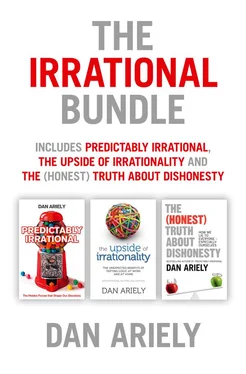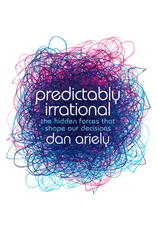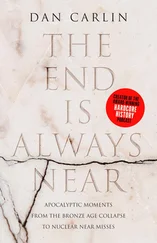Dan Ariely - The Irrational Bundle
Здесь есть возможность читать онлайн «Dan Ariely - The Irrational Bundle» — ознакомительный отрывок электронной книги совершенно бесплатно, а после прочтения отрывка купить полную версию. В некоторых случаях можно слушать аудио, скачать через торрент в формате fb2 и присутствует краткое содержание. Жанр: unrecognised, на английском языке. Описание произведения, (предисловие) а так же отзывы посетителей доступны на портале библиотеки ЛибКат.
- Название:The Irrational Bundle
- Автор:
- Жанр:
- Год:неизвестен
- ISBN:нет данных
- Рейтинг книги:3 / 5. Голосов: 1
-
Избранное:Добавить в избранное
- Отзывы:
-
Ваша оценка:
- 60
- 1
- 2
- 3
- 4
- 5
The Irrational Bundle: краткое содержание, описание и аннотация
Предлагаем к чтению аннотацию, описание, краткое содержание или предисловие (зависит от того, что написал сам автор книги «The Irrational Bundle»). Если вы не нашли необходимую информацию о книге — напишите в комментариях, мы постараемся отыскать её.
The Irrational Bundle — читать онлайн ознакомительный отрывок
Ниже представлен текст книги, разбитый по страницам. Система сохранения места последней прочитанной страницы, позволяет с удобством читать онлайн бесплатно книгу «The Irrational Bundle», без необходимости каждый раз заново искать на чём Вы остановились. Поставьте закладку, и сможете в любой момент перейти на страницу, на которой закончили чтение.
Интервал:
Закладка:
Although identifying and fighting the allure of FREE! is important in order to avoid traps while we are making decisions, there are also some cases in which we can use FREE! to our advantage. Take, for example, the common experience of going to a restaurant with friends. When the server drops off the check at the end of a meal, people often scramble to figure out the norms for payment. Do we each pay for what we ordered? Do we split the bill evenly, even if John had that extra glass of wine and the crème brûlée? FREE! can help us solve this problem, and in the process help us get more joy from dining out with our friends.
The answer, as it turns out, is that one person should pay the entire bill, and that the people involved should take turns paying over time. Here is the logic: When we pay—regardless of the amount of money—we feel some psychological pain, which social scientists call the “pain of paying.” This is the unpleasantness associated with giving up our hard-earned cash, regardless of the circumstances. It turns out that the pain of paying has two interesting features. First, and most obviously, when we pay nothing (for example, when someone else foots the bill) we don’t feel any pain of paying. Second, and less obviously, the pain of paying is relatively insensitive to the amount that we pay. This means that we feel more pain of paying as the bill increases, but every additional dollar on the bill pains us less. (We call this “diminishing sensitivity.” Analogously, if you add one pound to an empty backpack, it feels like a substantial increase in weight. But adding a pound to a backpack that’s already laden with a laptop and some books does not feel like a big difference.) This diminishing sensitivity to the pain of paying means that the first dollar we pay will cause us the highest pain, the second dollar will cause us less, and so on, until we feel just a tiny twinge for, say, the forty-seventh dollar.
So if we are dining with others, we are happiest when we pay nothing (FREE!); we are less happy when we have to pay something; and the additional dollars we fork over cause us a smaller and smaller additional amount of pain as the size of the bill increases. The logical conclusion is that one person should pay the whole bill.
If you’re still unconvinced, consider the following example: Imagine that four people share a meal and the bill comes to $100. Now, if everyone at the table pays $25, every person would feel some pain of paying. In order to make this less abstract, let’s assign “units” as a measure of this pain. We’ll assume that paying $25 translates into 10 units of pain for a total of 40 units of pain for the whole table when it comes time to split the bill. But what if one person pays the entire bill? Since the pain of paying does not increase linearly with the amount of payment, the person who is paying will feel 10 units of pain for the first $25 that he or she pays; maybe 7 units for the next $25; 5 units for the next $25; and 4 units for the last $25. The total of 26 units of pain lowers the amount of pain for the entire table by 14 units. The general point is this: we all love getting our meals for nothing, and as long as we can alternate payers, we can enjoy many FREE! dinners and derive greater overall benefit from our friendships in the process.
“Aha,” you might say, “but what about times when I eat only a green salad while my friend’s husband orders a green salad, a filet mignon dinner, two glasses of the most expensive cabernet sauvignon, and a crème brûlée for dessert? Or when the number of people changes the next time we gather? Or when some people in the group leave town altogether? All of this leaves me holding the bag.”
Certainly, there is no question that all these considerations make the “I’ll buy this time, you buy next time” approach less economically efficient. Nevertheless, given the huge benefits in terms of the pain of paying that this method delivers, I personally would be willing to sacrifice a few bucks here and there to reduce the pain of paying for my friends and myself.
Appendix: Chapter 3
Let me explain how the logic of standard economic theory would apply to our setting. When a person can select one and only one of two chocolates, he needs to consider not the absolute value of each chocolate but its relative value—what he gets and what he gives up. As a first step the rational consumer needs to compute the relative net benefits of the two chocolates (the value of the expected taste minus the cost), and make a decision based on which chocolate has the larger net benefit. How would this look when the cost of the Lindt truffle was 15 cents and the cost of the Hershey’s Kiss was one cent? The rational consumer would estimate the amount of pleasure he expects to get from the truffle and the Kiss (let’s say this is 50 pleasure units and five pleasure units, respectively) and subtract the displeasure he would get from paying 15 cents and one cent (let’s say this is 15 displeasure units and one displeasure unit, respectively). This would give him a total expected pleasure of 35 pleasure units (50 – 15) for the truffle, and a total expected pleasure of four pleasure units (5 - 1) for the Kiss. The truffle leads by 31 points, so it’s an easy choice—the truffle wins hands down.
What about the case when the cost is reduced by the same amount for both products? (Truffles cost 14 cents and the Kiss is free.) The same logic applies. The taste of the chocolates has not changed, so the rational consumer would estimate the pleasure to be 50 and five pleasure units, respectively. What has changed is the displeasure. In this setting the rational consumer would have a lower level of displeasure for both chocolates because the prices have been reduced by one cent (and one displeasure unit). Here is the main point: because both products were discounted by the same amount, their relative difference would be unchanged. The total expected pleasure for the truffle would now be 36 pleasure units (50 - 14), and the total expected pleasure for the Kiss would now be five pleasure units (5 - 0). The truffle leads by the same 31 points, so it should be the same easy choice. The truffle wins hands down.
This is how the pattern of choice should look, if the only forces at play were those of a rational cost-benefit analysis. The fact that the results from our experiments are so different tells us loud and clear that something else is going on, and that the price of zero plays a unique role in our decisions.
CHAPTER 4
The Cost of Social Norms
Why We Are Happy to Do Things, but Not
When We Are Paid to Do Them
You are at your mother-in-law’s house for Thanksgiving dinner, and what a sumptuous spread she has put on the table for you! The turkey is roasted to a golden brown; the stuffing is homemade and exactly the way you like it. Your kids are delighted: the sweet potatoes are crowned with marshmallows. And your wife is flattered: her favorite recipe for pumpkin pie has been chosen for dessert.
The festivities continue into the late afternoon. You loosen your belt and sip a glass of wine. Gazing fondly across the table at your mother-in-law, you rise to your feet and pull out your wallet. “Mom, for all the love you’ve put into this, how much do I owe you?” you say sincerely. As silence descends on the gathering, you wave a handful of bills. “Do you think three hundred dollars will do it? No, wait, I should give you four hundred!”
This is not a picture that Norman Rockwell would have painted. A glass of wine falls over; your mother-in-law stands up red-faced; your sister-in-law shoots you an angry look; and your niece bursts into tears. Next year’s Thanksgiving celebration, it seems, may be a frozen dinner in front of the television set.
WHAT’S GOING ON here? Why does an offer for direct payment put such a damper on the party? As Margaret Clark, Judson Mills, and Alan Fiske suggested a long time ago, the answer is that we live simultaneously in two different worlds—one where social norms prevail, and the other where market norms make the rules. The social norms include the friendly requests that people make of one another. Could you help me move this couch? Could you help me change this tire? Social norms are wrapped up in our social nature and our need for community. They are usually warm and fuzzy. Instant paybacks are not required: you may help move your neighbor’s couch, but this doesn’t mean he has to come right over and move yours. It’s like opening a door for someone: it provides pleasure for both of you, and reciprocity is not immediately required.
Читать дальшеИнтервал:
Закладка:
Похожие книги на «The Irrational Bundle»
Представляем Вашему вниманию похожие книги на «The Irrational Bundle» списком для выбора. Мы отобрали схожую по названию и смыслу литературу в надежде предоставить читателям больше вариантов отыскать новые, интересные, ещё непрочитанные произведения.
Обсуждение, отзывы о книге «The Irrational Bundle» и просто собственные мнения читателей. Оставьте ваши комментарии, напишите, что Вы думаете о произведении, его смысле или главных героях. Укажите что конкретно понравилось, а что нет, и почему Вы так считаете.












